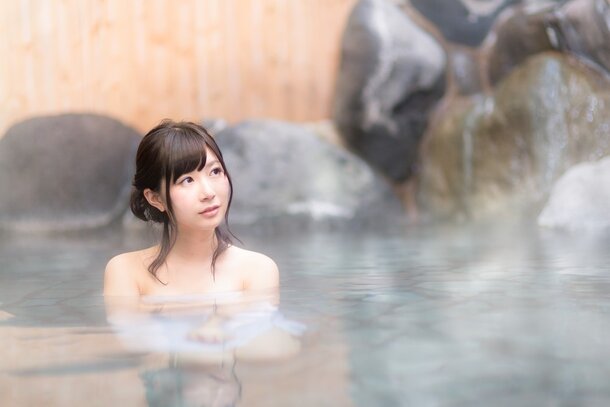Those of you with long hair, you tie up your hair when soaking in the tub, right?
Taking this habit as its base, there is an observation that became a hot topic on Twitter: If the character doesn’t have her hair tied up in a bathing scene in an anime or manga, it means the creator is most probably male.

If you soak in the bathtub with your long hair down, your hair takes in the moisture and sticks to your skin in locks. If one were to describe it as it is, you basically end up in a Sadako-like state with you hair sticking flat, losing all your beauty and cuteness. Plus it’s very unhygienic to put your dusty and dirty hair in the tub after having it exposed to the outside air all day if you’re not the last to use the bathing water, so people usually don’t do it.
Washing hair in a shower scene right before going to bed?
To verify the truth of the Twitter post, anime shots depicting long-haired female characters soaking in the tub with their hair down were posted. Upon inspection, all of them were taken from works of male creators. In addition, there were also scenes of girls standing in the shower with their hair down or washing their hair right before bed. I thought, this must be because the creators were male, and when I checked, I found that the anime these scenes were taken from were also made by male directors.
Finding exceptions
There is a scene in the currently on-air anime titled Is the Order a Rabbit? (Tokyo MX) where Rize-chan is soaking in the tub with her hair tied up as it should be. Since the director is male, you would think there are exceptions, too, but the gender of the original creator is unknown and there is the possibility of her being a woman. But as to whether there are exceptions where both the original creator and the director are male, the answer is yes. In Neon Genesis Evangelion, both Asuka and Misato have their hair properly tied up.
In manga
When I investigated bathing and showering scenes in manga, I found that in the case of male authors, these scenes are often depicted hair down, and there were also many instances of girls showering with their hair down or even going as far as washing their hair right before going to bed. I guess long hair is most beautiful in its natural state...
However, there were exceptions in this case, too. In Jotei (Super Queen) (original concept by Ryo Kurashina and illustrated by Issaku Wake), the protagonist Ayaka properly tied up her beautiful long hair when showering before bed! It seems the grand masters who have expressed the passion of men and women in their works for a long time do place importance on reality.
These days, long hair is considered sexier than the nape?
I thought about the matter of why they’re depicted with their long hair down in bath scenes from my own perspective as a former SM Queen and an erotic columnist.
As revealing Western clothing has become everyday wear, there are less people drawn to the nape, which, linked with the non-revealing kimono, used to be the synonym of sexiness. Since Western clothing reveals much under the neck, it is a possibility that covering what is above came to be considered more sexy. For that reason, I think that drawing characters with their hair down in bath scenes, even if it’s unrealistic, is a way of emphasising sexiness and deodorizing the lifelikeness of it.
Regarding showering right before bed, in addition to the reasons above, it might be the result of influence taken from a habit characteristic to men, that is, they wash their hair every time they take a bath and they have no idea about the time it takes to dry such long hair. If you wash your hair right before bed, it could take more than 30 minutes to dry, taking the mood and tension with it, it’s absolutely out of the question. And if you go to bed with your hair all wet, the dampness will bother you and it will make the sheets wet, too; it takes out all the fun.
Many of the comments were along the lines of “since anime and manga are fantasies, there’s nothing wrong with it.” It is true that there’s no problem as long as the readers and the audience don’t think it’s odd. However, it seems there are also many of those who, like me, are thoroughly uncomfortable with it.
Seeing there are also exceptions, I wouldn’t say you can tell the creator’s gender with this method, but there is definitely a visible trend, and with that I conclude my article.
*The picture is an example. Model: Saori Ito / Pakutaso
Source: Otakuma Keizai Shimbun
Source article written by Daria Kizaki.

 Shopping Guide
Shopping Guide



